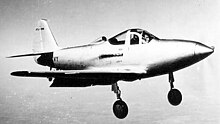Bell XFL Airabonita
| XFL Airabonita | |
|---|---|

| |
| Role | Fighter |
| Manufacturer | Bell Aircraft |
| First flight | 13 May 1940 |
| Status | Cancelled |
| Primary user | United States Navy |
| Number built | 1 |
| Developed from | Bell P-39 Airacobra |
The Bell XFL Airabonita was a United States experimental shipboard interceptor aircraft developed for the United States Navy by Bell Aircraft. It was similar to and a parallel development of the land-based P-39 Airacobra, differing mainly in the use of a tailwheel undercarriage in place of the P-39's tricycle gear. Only one prototype was manufactured.
Design and development
The XFL-1 (Bell Model 5) was powered by a single Allison XV-1710-6 piston engine installed amidships behind the pilot and driving a three bladed Curtiss propeller in the nose through a 10.38 ft (3.16 m) extension shaft. The aircraft had provisions for a single 37 mm (1.46 in) Oldsmobile T9 cannon which could be replaced by a .50 in (12.7 mm) Browning M2/AN machine gun through the propeller shaft and two .30 in (7.62 mm) machine guns in the fuselage nose. It first flew on 13 May 1940.[1]
Although based on the P-39, the XFL-1 utilised a conventional tail-wheel undercarriage and the coolant radiators were housed externally in fairings under the wings instead of within the wing center section. The Allison engine was the first of its type to be tried out by the Navy and lacked the turbosupercharger fitted to the XP-39.[N 1][1]
Operational history

Delivery of the prototype to the U.S. Navy was delayed due to difficulties with the Allison engine until February 1941 and it was not accepted as navy property until March.[1] During tests, the aircraft was plagued with engine and landing gear problems and was returned to Bell for modifications in December 1941, but before the modifications were completed, the U.S. Navy decided that the XFL-1 was not suitable for further development.[1]
As a possible further reason for the rejection it is often stated that the Navy's position during that era was that all its aircraft should use air-cooled engines (while the Allison was liquid-cooled). This appears unfounded speculation. The U.S. Navy "would consider a liquid-cooled engine installation provided a material increase in performance over air-cooled engine can be shown."[2]
In addition, the Allison engine had only a single-speed supercharger, consequently, its altitude performance was much inferior to other naval fighters of the period such as the Grumman F4F Wildcat. [N 2]
Lastly, the Airabonita had to compete against the considerably faster Vought F4U Corsair, the first U.S. Navy fighter to exceed 400 mph (644 km/h) in level flight.[3]
The XFL-1 was later used for non-flying armament tests, and later destroyed. For many years its remains were visible at the dump at U.S. Naval Air Station Patuxent River, Maryland.[4][5]
Operators
Specifications (XFL-1 Airabonita)

Data from [citation needed]
General characteristics
- Crew: One
Performance
Armament
- Guns:
- 2 × 0.30 cal (7.62 mm) machine guns
- 1 × 0.50 cal (12.7 mm) machine gun or 37 mm cannon
See also
Related development
References
Notes
- ^ Note: Navy engines were distinguished by the use of an even dash number while those for the Army used odd ones.
- ^ The U.S. Army Air Corp's P-39 and Curtiss P-40, which used the same engine, had the same difficulty; the Lockheed P-38 Lightning used the same engines but incorporated exhaust-driven superchargers to achieve good altitude performance.
Citations
Bibliography
- Bowers, Peter M. "Airborne Cobra Pt.II". Airpower, Vol. 9, No. 1, January 1979.
- Dorr, Robert F. and Jerry C. Scutts. Bell P-39 Airacobra. Ramsbury, Marlborough, Wiltshire, UK: The Crowood Press Ltd., 2000. ISBN 1-86126-348-1.
- Green, William. "Bell XFL-1 Airabonita". War Planes of the Second World War, Volume Four: Fighters. London: Macdonald & Co. (Publishers) Ltd., 1961 (6th impression 1969), pp. 13–14. ISBN 0-356-01448-7.
- Green, William and Gordon Swanborough. "Bell XFL-1 Airabonita". WW2 Aircraft Fact Files: US Navy and Marine Corps Fighters. London: Macdonald and Jane's Publishers Ltd., 1976, p. 3. ISBN 0-356-08222-9.
- Kinzey, Bert. "XFL-1 Airabonita". P-39 Airacobra - in detail. Carrollton, Texas: Squadron/Signal Publications Inc., 1999, p. 8. ISBN 978-1-88897-416-4.
- Thomason, Tommy. Bell XFL-1 Airabonita (Naval Fighters Number Eighty-One). Simi Valley, California: Ginter Books, 2008. ISBN 0-942612-81-7.
- Tomalik, Jacek. Bell P-6 Kingcobra, XFL-1 Airabonita, P-39 Airacobra (Monografie Lotnicze 59) (in Polish). Gdansk, Poland: AJ-Press, 2001. ISBN 83-7237-034-6.
